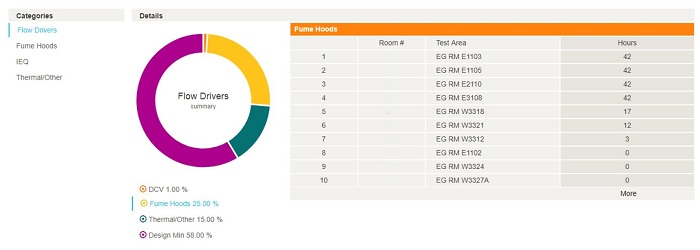Aircuity, creator of measurably better environments, announces the release of new features and enhancements to Aircuity 2.0’s MyAircuity web app. The MyAircuity web app houses Aircuity’s intelligent analytics along with offering graphing and exporting for further exploration of trends seen on the dashboard. The newly released functionality will help provide even more insight on clients’ buildings. This most recent release also included both new features and enhancements made to the Aircuity Engineering Tool; the proprietary software used by engineers to design the Aircuity system.

The new MyAircuity enhancements include the following:
- Flow Drivers: New dashboard items display the driver of increased ventilation rates into a room. Ventilation may be driven by demand control, fume hoods, thermal loads or a design minimum. This new dashboard control will show the user the specific flow driver in each room of their building and allow the user to graph the results.
- Improved Data Export Format: Enhancements were made in MyAircuity’s Graphing & Exporting component to the Microsoft® Excel export format for data. Points are now listed in the header and the time stamps and data value for each point are included in columns, making it easier to graph and analyze exported data.
- Monitoring – Improved Issue Assignment: When an event is sent by the Aircuity Platform’s Information Management System (IMS) and an issue gets created in the system, the issue is now automatically assigned to the appropriate client services team member. This means an expedited resolution for the client.
The next generation platform, Aircuity 2.0, was officially released Q2 of 2017 and includes both the MyAircuity web app and upgrades to the physical Aircuity system. The Aircuity 2.0 platform provides customers with an enhanced indoor environmental quality, verifiable energy savings and intelligent analytics for a variety of constituents.
ABOUT AIRCUITY
Aircuity creates smart airside solutions through its intelligent building platform, significantly reducing energy costs and improving the indoor environmental quality for occupants. As the demand control solution, Aircuity optimizes ventilation rates through its patented technology. As a result, commercial, institutional and lab building owners can lower operating costs, protect occupants and verifiably reduce energy use by as much as 60 percent. Founded in 2000 and headquartered in Newton, MA, Aircuity’s solutions have benefited over 400 organizations such as Google, Amazon, Eli Lilly, Masdar City, the University of Pennsylvania, and the University of California-Irvine. For additional information on the company and its solutions, please visit: www.aircuity.com.










































